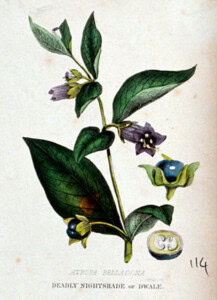Poisonous Plants
This October half term, as spooky season sets in, we’ve been exploring the darker side of botany by taking a closer look at the effects and uses of poisonous plants.
Poisons were widely available in the Victorian era, many of which were derived from plants. Though they were mainly used for cosmetic and medicinal purposes, the introduction and establishment of life insurance policies during this period provided a profitable new motive for their use.
This October half term, as spooky season sets in, we’ve been exploring the darker side of botany by taking a closer look at the effects and uses of this fearsome foliage. Below is a list of poisonous plants that were in documented use in 19th century Britain. Uncover how they found their way into everything from cosmetics, medicinal remedies, food and even home decor – along with the ailments that might befall you should you brush up against one of these frightful flora for yourself.
Make sure to come along to our Woeful Wounds activity when you visit this half term where students from SGS college will be recreating some of these side effects of these toxic plants through the medium of SFX makeup. Have a browse through this list and pick your poison – from boils to cuts to grazes, the choice is yours!
Belladonna

Atropa belladonna – more commonly known as deadly nightshade – is possibly one of the most famous dangerous plants. It has a long and twisted history of various medicinal, murderous, and cosmetic uses and sometimes plays quite sinister roles in folklore and legends.
Symptoms: can induce redness of skin, hives or welts if brought into contact with the skin.
Datura
Datura stramonium – also known as Jamestown weed or thornapple – can be an attractive addition to gardens, particularly in tropical style plantings. Some seed companies sell it, emphasizing its value as an ornamental annual plant. At night, the flowers open fully and release a pleasant scent, attracting moths.
Symptoms: can cause dry, red irritations on sensitive skin.
Mandrake

Another member of the nightshade family, a mandrake is the root of a plant derived from plants of the genus Mandragora. All parts of the Mandragora species are poisonous, but the roots – which are said to resemble the human form – are especially toxic when eaten. They have long been associated with witchcraft, magic, and superstitious practices.
Symptoms: Can cause acute dermatitis and skin rashes.
Strychnine
Strychnos nux-vomica – the strychnine tree – is one of nearly 200 species of tropical woody plants that make up the genus Strychnos and belong to the family Loganiaceae. The flowers are small and usually white or creamy in colour, and the seeds are a source of the extremely poisonous compound strychnine. Many other plants in the Loganiaceae family are also toxic, such as Strychnos toxifera – also known as devil doer – whose bark is a natural source of the poison curare.
Symptoms: Can cause swollen and sensitive skin.
Written by Natalie Fey, Interpretation Manager.
Image attribution:
Header: M0005919: Atropa Belladonna (deadly nightshade), from Bentley and Trimen: Medicinal plants (1880). Source: Wellcome Collection
Belladonna: Deadly nightshade (Atropa belladonna), detail from Four Poisonous Plants coloured engraving by J. Johnstone, 1855. Wellcome Collection. Source: Wellcome Collection
Mandrake: Mandrake: male. Wellcome Collection. Source: Wellcome Collection.



